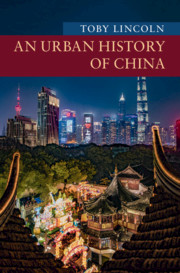Book contents
- An Urban History of China
- New Approaches to Asian History
- An Urban History of China
- Copyright page
- Contents
- Figures
- Maps
- Tables
- Acknowledgements
- Introduction
- 1 The Emergence of China’s Imperial Urban Civilization (Antiquity to 220 CE)
- 2 The Expansion of China’s Imperial Urban Civilization to the South (220–755)
- 3 The Tang-Song Transition and Its Effects on China’s Imperial Urban Civilization (907–1402)
- 4 The Flowering of Chinese Imperial Urban Civilization (1402–1799)
- 5 The Seeds of Urban Modernity (1800–1895)
- 6 Urban Modernity in Republican China (1895–1949)
- 7 The Maoist Period (1949–1976)
- 8 The Reform Era and the Present
- Conclusion
- Index
- Series page
- References
Introduction
Published online by Cambridge University Press: 29 April 2021
- An Urban History of China
- New Approaches to Asian History
- An Urban History of China
- Copyright page
- Contents
- Figures
- Maps
- Tables
- Acknowledgements
- Introduction
- 1 The Emergence of China’s Imperial Urban Civilization (Antiquity to 220 CE)
- 2 The Expansion of China’s Imperial Urban Civilization to the South (220–755)
- 3 The Tang-Song Transition and Its Effects on China’s Imperial Urban Civilization (907–1402)
- 4 The Flowering of Chinese Imperial Urban Civilization (1402–1799)
- 5 The Seeds of Urban Modernity (1800–1895)
- 6 Urban Modernity in Republican China (1895–1949)
- 7 The Maoist Period (1949–1976)
- 8 The Reform Era and the Present
- Conclusion
- Index
- Series page
- References
Summary
This book is a history of Chinese cities from their origins to the present. Despite being an agricultural society for thousands of years, China had a dynamic imperial urban civilization. This consisted of a complex empire-wide urban system linking cities, towns, and villages. Although there was variation across the empire, there was a recognizable Chinese urban form, especially in imperial capitals. At the same time, cities were managed by a mixture of Chinese officials and organizations such as migrant associations. Finally, a vibrant urban culture developed that distinguished cities from the countryside that surrounded them. Then, over the past century, because of a number of historical forces, including industrialization and the emergence of governments committed to urbanization, this urban civilization was transformed into the world’s largest modern urban society. Indeed now, with some of the largest cities and most densely populated and networked cities in the world, China is shaping what it means to be a modern urban society. Like those throughout China’s history, these cities are connected to others around the world, and by highlighting these links, this book writes China into the history of how the world has become a modern urban society.
- Type
- Chapter
- Information
- An Urban History of China , pp. 1 - 14Publisher: Cambridge University PressPrint publication year: 2021

